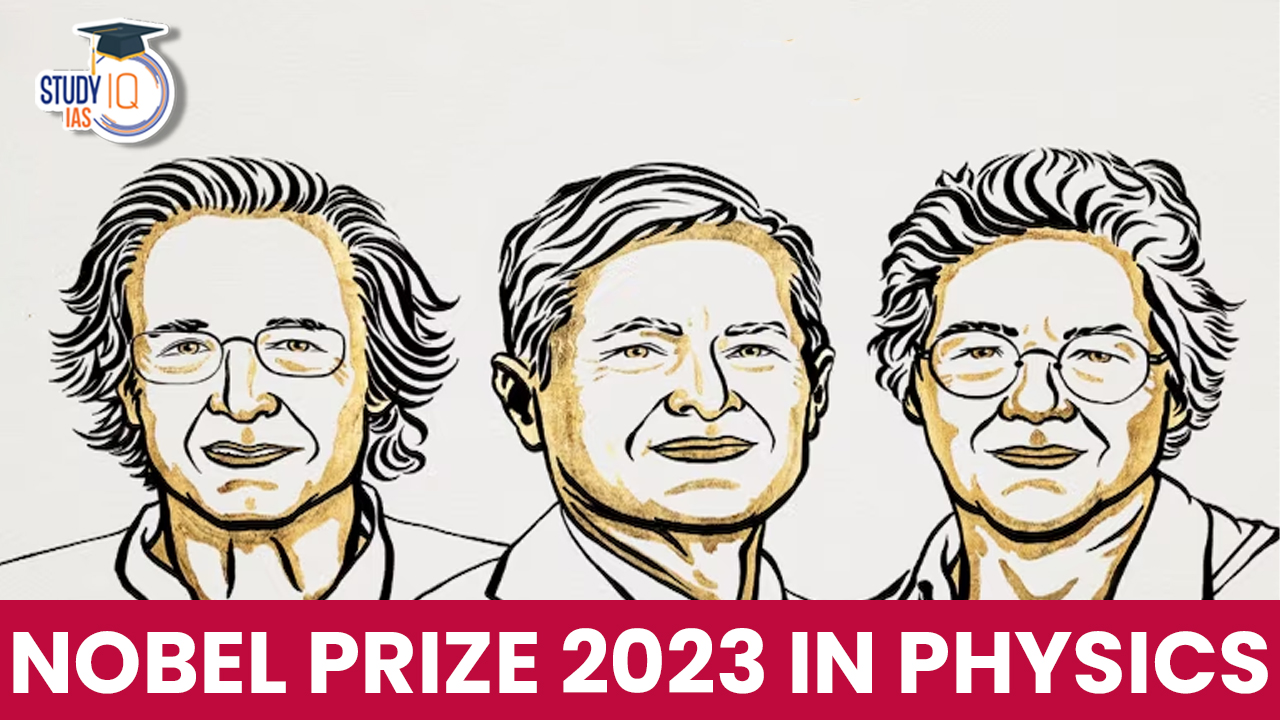Table of Contents
The 2023 Nobel Prize in Physics was awarded jointly to Pierre Agostini, Ferenc Krausz, and Anne L’Huillier for their groundbreaking work in the field of attosecond physics. This field involves the study of extremely fast processes at the atomic and subatomic levels by generating attosecond pulses of light.
Nobel Prize in Physics 2023
The work of Anne L’Huillier, Pierre Agostini, and Ferenc Krausz revolves around creating attosecond pulses of light, lasting only attoseconds (1×10^-18 of a second). These pulses act as ultrafast “shutters” to capture events at the atomic scale.
Read More: Noble Prize 2022 winners list
Nobel Prize in Physics Winners for Attosecond Physics
Atoms are the fundamental building blocks of matter, consisting of a nucleus containing protons and neutrons, with electrons orbiting the nucleus. Electrons move at incredibly high speeds, making it impossible to observe their movements in real time using conventional techniques.
Anne L’Huillier’s Discovery
In 1987, Anne L’Huillier made a groundbreaking discovery when she passed laser light waves through a noble gas. This laser light interacted with the gas atoms, imparting additional energy to some of the electrons within the atoms. These excited electrons released the extra energy in the form of light emission.
Read about: Nobel Prize 2023
Pierre Agostini’s Contribution
In 2001, Pierre Agostini achieved a significant milestone by producing consecutive light pulses, each lasting an astonishingly short duration of only 250 attoseconds. This breakthrough allowed for the study of ultrafast processes in matter with unprecedented temporal resolution.
Read More: Nobel Peace Prize for 2023
Ferenc Krausz’s Innovation
Concurrently, Ferenc Krausz developed a unique experimental setup that enabled the isolation of a single light pulse lasting 650 attoseconds. This innovation provided even greater precision and control over the observation of atomic and subatomic phenomena.
Read about: Nobel Prize 2023 in Literature
Significance of Attosecond Physics
Attosecond physics has opened up new possibilities for understanding the dynamics of electrons, offering insights into fundamental atomic and molecular processes.
This knowledge has far-reaching applications, including potential advancements in healthcare, such as studying molecular changes in blood to identify diseases and improving electronic devices through a deeper understanding of electron movement and energy transmission.
Read about: Nobel Prize 2023 in Chemistry
Nobel Prize in Physics Winners List (2011-2023)
|
Nobel Prize in Physics Winners List |
|||
| 2011 |
Saul Perlmutter | U.S. | discovery of the accelerating expansion of the universe through observations of distant supernovae |
| Brian P. Schmidt | U.S./Australia | discovery of the accelerating expansion of the universe through observations of distant supernovae | |
| Adam G. Riess | U.S. | discovery of the accelerating expansion of the universe through observations of distant supernovae | |
| 2012 | Serge Haroche | France | development of methods that enable measuring and manipulation of individual quantum systems |
| David J. Wineland | U.S. | development of methods that enable measuring and manipulation of individual quantum systems | |
| 2013 | François Englert | Belgium | theoretical discovery of a mechanism that contributes to the understanding of the origin of mass of subatomic particles |
| Peter Higgs | U.K. | theoretical discovery of a mechanism that contributes to the understanding of the origin of mass of subatomic particles | |
| 2014 | Akasaki Isamu | Japan | invention of efficient blue light-emitting diodes, which has enabled bright and energy-saving white light sources |
| Amano Hiroshi | Japan | invention of efficient blue light-emitting diodes, which has enabled bright and energy-saving white light sources | |
| Shuji Nakamura | U.S. | invention of efficient blue light-emitting diodes, which has enabled bright and energy-saving white light sources | |
| 2015 | Kajita Takaaki | Japan | discovery of neutrino oscillations, which show that neutrinos have mass |
| Arthur B. McDonald | Canada | discovery of neutrino oscillations, which show that neutrinos have mass | |
| 2016 | David Thouless | U.K. | theoretical discoveries of topological phase transitions and topological phases of matter |
| Duncan Haldane | U.K. | theoretical discoveries of topological phase transitions and topological phases of matter | |
| Michael Kosterlitz | U.K. | theoretical discoveries of topological phase transitions and topological phases of matter | |
| 2017 | Barry C. Barish | U.S. | decisive contributions to the Laser Interferometer Gravitational-Wave Observatory detector and the observation of gravitational waves |
| Kip S. Thorne | U.S. | decisive contributions to the Laser Interferometer Gravitational-Wave Observatory detector and the observation of gravitational waves | |
| Rainer Weiss | U.S. | decisive contributions to the Laser Interferometer Gravitational-Wave Observatory detector and the observation of gravitational waves | |
| 2018 | Arthur Ashkin | U.S. | invention of optical tweezers and their application to biological systems |
| Gérard Mourou | France | invention of a method of generating high-intensity ultra-short optical pulses | |
| Donna Strickland | Canada | invention of a method of generating high-intensity ultra-short optical pulses | |
| 2019 | James Peebles | Canada/U.S. | theoretical discoveries in physical cosmology |
| Michel Mayor | Switzerland | discovery of an exoplanet orbiting a solar-type star | |
| Didier Queloz | Switzerland | discovery of an exoplanet orbiting a solar-type star | |
| 2020 | Reinhard Genzel | Germany | discovery of a supermassive compact object at the centre of the Milky Way Galaxy |
| Andrea Ghez | U.S. | discovery of a supermassive compact object at the centre of the Milky Way Galaxy | |
| Roger Penrose | U.K. | discovery that black hole formation is a robust prediction of the general theory of relativity | |
| 2021 | Klaus Hasselmann | Germany | development of the foundation for human knowledge of the Earth’s climate and how humanity influences it |
| Manabe Syukuro | Japan/U.S. | development of the foundation for human knowledge of the Earth’s climate and how humanity influences it | |
| Giorgio Parisi | Italy | discovery of the interplay of disorder and fluctuations in physical systems from atomic to planetary scales | |
| 2022 | Alain Aspect | France | experiments with quantum entanglement that laid the foundation for a new era of quantum technology |
| John F. Clauser | U.S. | experiments with quantum entanglement that laid the foundation for a new era of quantum technology | |
| Anton Zeilinger | Austria | experiments with quantum entanglement that laid the foundation for a new era of quantum technology | |
| 2023 | Pierre Agostini | France | development of experimental methods that generate attosecond pulses of light for the study of electron dynamics in matter |
| Ferenc Krausz | Hungary | development of experimental methods that generate attosecond pulses of light for the study of electron dynamics in matter | |
| Anne L’Huillier | France | development of experimental methods that generate attosecond pulses of light for the study of electron dynamics in matter | |
Nobel Prize in Physics UPSC
The 2023 Nobel Prize in Physics was awarded to Pierre Agostini, Ferenc Krausz, and Anne L’Huillier for their pioneering work in attosecond physics, which explores ultra-fast atomic and subatomic processes using attosecond light pulses. This breakthrough allows us to capture events at the atomic scale. L’Huillier’s 1987 discovery involved laser light and gas atoms, while Agostini achieved consecutive 250 attosecond light pulses in 2001. Krausz’s innovation isolated a single 650-attosecond light pulse. Attosecond physics promises a deeper understanding of electron dynamics and has wide-ranging applications, from healthcare to electronic devices.
Read about: Nobel Prize 2023 in Physiology or Medicine


 Daily Quiz 18 April 2025
Daily Quiz 18 April 2025
 OSSC CGL Syllabus 2025 and Exam Pattern ...
OSSC CGL Syllabus 2025 and Exam Pattern ...
 AI and its Regulation in India, Limitati...
AI and its Regulation in India, Limitati...





















